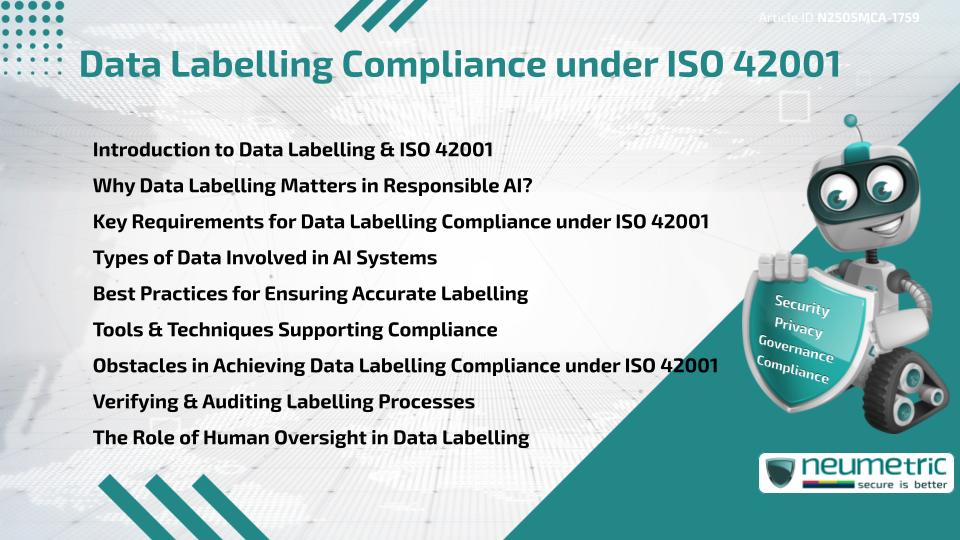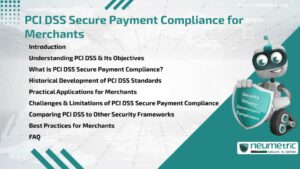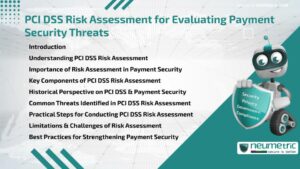Table of Contents
ToggleIntroduction to Data Labelling & ISO 42001
The rise of Artificial Intelligence [AI] has led to the creation of frameworks like ISO 42001, which guide Organisations in the ethical development & deployment of AI Systems. At the heart of these guidelines lies data labelling Compliance under ISO 42001—a key requirement to ensure fairness, accuracy & accountability in AI decision-making.
Data labelling involves assigning relevant tags or annotations to raw datasets—like images, text or audio—so that AI systems can interpret & learn from them. Whether it is marking an email as spam or categorising medical images, these labels influence how the AI behaves. Under ISO 42001, this seemingly technical step is treated as a Governance responsibility.
Why Data Labelling Matters in Responsible AI?
For an AI System to make trustworthy decisions, the data it trains on must be accurate & representative. Inaccurate or biased labelling can lead to harmful consequences—discriminatory algorithms, misdiagnosed medical results or faulty automated processes.
Data labelling Compliance under ISO 42001 ensures that Organisations maintain high standards for how data is labeled & verified. It treats data annotation as a crucial part of the Risk Management process & requires that each step aligns with ethical AI principles. It also mandates attention to data provenance, human oversight & error handling.
Key Requirements for Data Labelling Compliance under ISO 42001
Under the ISO 42001 Framework, the following requirements are particularly relevant to data labelling:
- Transparency: Organisations must document how labelling was performed & by whom.
- Accuracy: Labels must reflect the true nature of the data, without introducing bias.
- Human Oversight: Annotators should be trained, monitored & involved in reviewing edge cases.
- Data Provenance: All data sources should be traceable & used with proper consent.
- Error Handling: Mistakes in labelling should be identified & corrected with documented processes.
These requirements encourage accountability & provide a structured way to Audit labelling practices.
Types of Data Involved in AI Systems
The labelling process must adapt to different kinds of data that AI Systems use:
- Text: Natural language processing applications rely on well-tagged data for sentiment analysis or chatbot training.
- Images & Video: Autonomous vehicles & medical imaging systems require pixel-accurate annotations.
- Audio: Voice assistants & speech recognition tools use labeled audio clips for training.
- Structured Data: Even numerical or tabular datasets need context-aware tagging.
Data labelling Compliance under ISO 42001 requires that each data type is treated with attention to context, consent & impact.
Best Practices for Ensuring Accurate Labelling
To stay compliant with ISO 42001, Organisations can adopt these practical methods:
- Use diverse labelling teams to reduce cognitive & cultural bias.
- Develop standardised labelling guidelines that explain how to handle ambiguities.
- Perform inter-rater reliability checks to ensure consistency.
- Integrate Feedback Loops to continuously improve labelling quality.
- Retain Audit logs for all labelling sessions & revisions.
These steps promote transparency & provide evidence during Compliance audits.
Tools & Techniques Supporting Compliance
Various tools & platforms can support data labelling Compliance under ISO 42001, especially when scaling operations. These may include:
- Annotation tools with built-in quality checks
- Dashboards for tracking labelling metrics
- Automation-assisted labelling to reduce repetitive tasks
- Data version control tools help monitor & record updates made to labels across different points in time
Such tools should align with the ISO 42001 principle of explainability & be auditable.
Obstacles in Achieving Data Labelling Compliance under ISO 42001
Despite best intentions, many Organisations face barriers:
- Scalability Issues: Labelling thousands of data points manually is time-consuming & error-prone.
- Subjectivity: Interpreting data differently can lead to inconsistent labels.
- Lack of Training: Annotators may not fully understand the context of the data.
- Tool Limitations: Off-the-shelf tools may not meet Compliance standards.
Organisations need to acknowledge these limitations & develop robust data handling processes to address them effectively.
Verifying & Auditing Labelling Processes
ISO 42001 places a strong emphasis on internal audits & Third Party assessments. When it comes to data labelling, audits must verify:
- Compliance with documented labeling protocols
- Accuracy & completeness of annotations
- Logs of changes & error corrections
- Feedback mechanisms from AI outcomes to labelling teams
Data labelling Compliance under ISO 42001 cannot be proven without a trail of verifiable actions.
The Role of Human Oversight in Data Labelling
While automation has improved labelling speed, human oversight remains essential. Human reviewers are needed to:
- Resolve ambiguous or edge-case annotations
- Detect nuanced errors that machines may miss
- Assess labelling fairness across demographic groups
Without this oversight, automated labelling can introduce serious bias. ISO 42001 insists that people remain responsible for critical decisions involving data.
Takeaways
- Data labelling Compliance under ISO 42001 ensures ethical, accurate & transparent AI Model training.
- Organisations must maintain robust documentation, oversight & review mechanisms for labelling
- A mix of human judgment & technological tools is key to meeting Compliance goals.
- Consistent audits & quality checks are non-negotiable elements of responsible AI deployment.
FAQ
What is data labelling Compliance under ISO 42001?
It refers to the practice of meeting ISO 42001’s standards for ethically & accurately tagging data used in AI Systems.
Why is data labelling so important in ISO 42001?
Incorrectly labeled data may cause AI systems to make flawed decisions, highlighting the importance of ethical labelling for building reliable & fair AI.
Who is responsible for data labelling Compliance under ISO 42001?
Organisations deploying AI Systems are accountable, but Compliance involves labellers, auditors & Governance teams.
How can Organisations Audit their data labelling practices?
They should document every step, keep change logs & perform internal or Third Party audits regularly.
What are the consequences of non-Compliance?
Failing to comply with labelling standards can result in unfair AI behaviour, potential legal issues or harm to an organisation’s reputation.
Can automation replace human oversight in data labelling?
No. ISO 42001 requires human involvement to resolve ambiguity & ensure fairness.
What kind of data is usually labeled for AI Systems?
Text, image, audio & structured datasets are most commonly labeled depending on the AI use case.
How often should labelling practices be reviewed?
At least once a year or when new data types or ethical concerns arise.
What tools support data labelling Compliance under ISO 42001?
Annotation tools with Audit features, tracking dashboards & labelling guidelines help ensure Compliance.
Need help?
Neumetric provides organisations the necessary help to achieve their Cybersecurity, Compliance, Governance, Privacy, Certifications & Pentesting goals.
Organisations & Businesses, specifically those which provide SaaS & AI Solutions, usually need a Cybersecurity Partner for meeting & maintaining the ongoing Security & Privacy needs & requirements of their Clients & Customers.
SOC 2, ISO 27001, ISO 42001, NIST, HIPAA, HECVAT, EU GDPR are some of the Frameworks that are served by Fusion – a centralised, automated, AI-enabled SaaS Solution created & managed by Neumetric.
Reach out to us!





